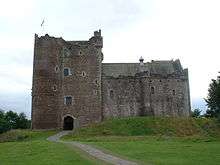The Bonnie Earl O' Moray

"The Bonnie Earl o' Moray" is a popular Scottish ballad, which may date from as early as the 17th century. It is catalogued as Child Ballad No. 181.[1][2] Versions can be heard on Isla St Clair's album Great Songs and Ballads of Scotland and Irish-American singer Robbie O'Connell's album Close to the Bone.
Background

The ballad touches on a true story stemming from the rivalry of James Stewart, Earl of Moray (pronounced Murray), and the Earl of Huntly, which culminated in Huntly's murder of Moray in 1592. The exact circumstances that led to the murder are not known for certain, but both their families, the Stewarts of Doune (pronounced "doon") and the Gordons of Huntly, had a history of territorial rivalry and competition for royal favour. In his notes on the ballad Francis James Child relates how Huntly, eager to prove that Moray was plotting with the Earl of Bothwell against King James VI, received a commission to bring Moray to trial. In the attempt to apprehend Moray, the earl's house at Donibristle in Fife was set on fire and the visiting Sheriff of Moray killed. Moray fled the house, but was chased and killed in its grounds, betrayed, it was said, by the glow of his burning helmet tassle. His last words, according to the (probably apocryphal) story related by Walter Scott, deserve special mention. Huntly slashed him across the face with his sword, and as he lay dying Moray said "Ye hae spilt a better face than yer ain" ("You have spoiled a better face than your own"). The killing was widely condemned. Moray's mother, Margaret Campbell, had a painting made of her son's dead body, as evidence of his multiple wounds, bearing the legend "God Revenge My Caus". Her intention was to show this publicly at the Cross in Edinburgh, but the King ignored her request, effectively withholding permission.[3]
Lyrics and themes

The King's reaction in the ballad is to condemn Huntly's action (in verse 2):
- "Now wae be to thee, Huntly!
- And wherefore did you sae?
- I bade you bring him wi you,
- But forbade you him to slay."
Nevertheless, James did not punish Huntly, prompting rumours of his own complicity in the murder. It is possible that the inclusion of the King's clear condemnation of the deed (whether or not it was ever expressed by him) was an effort to prevent the ballad from appearing treasonous. However, we can discount the ballad's claim that Moray was the Queen's lover (hinting at a possible motive for James's complicity). The ballad, which praises Moray as "a braw gallant" (Scots, calland), was most likely composed by one of his supporters. The words "Oh he might have been a king!" should not be taken to imply that he could have become King. More likely, they conveyed the sense that he possessed the required attributes of a king and so could easily have been one.
It is from the first verse of "The Bonnie Earl o' Moray" that the term mondegreen, meaning a misheard lyric, came into popular use among folk musicians.
- Ye Highlands and ye Lawlands,
- Oh where have you been?
- They have slain the Earl o' Moray
- And layd him on the green.
When the ballad is sung in Scots, the form is different from the more anglicised version in the Child catalogue. For example, the verses given above are sung with these words:
- Ye Hielands an ye Lowlands
- O, whaur hae ye been
- They hae slain the Earl o' Moray
- And lain him on the green.
- Now wae betide thee, Huntly
- And whaurfor did ye sae?
- I hae bade ye bring him wi ye
- But forbade ye him tae slay.
A German translation by Johann Gottfried Herder, Murrays Ermordung, published 1778–79, was set to music by Johannes Brahms in 1858.[4] The ballad was also set to music by Benjamin Britten.
Mondegreen
The American writer Sylvia Wright coined the term "mondegreen" in an essay "The Death of Lady Mondegreen," which was published in Harper's Magazine in November 1954.[5] In the essay, Wright described how, as a young girl, she misheard the final two lines of the above verse as "they have slain the Earl o' Moray, and Lady Mondegreen." She said that she always imagined the Earl dying beside his faithful lover "Lady Mondegreen", and refused to hear the real words, because they were less romantic than her misheard version. The term "mondegreen" has since been adopted for any misheard song lyric which changes the meaning of the original.
Recordings
- Robin Hall and Jimmie Macgregor – Scottish Choice, Decca ACL 1065 (1961)
See also
References
- ↑ The English and Scottish Popular Ballads, Edited by Francis James Child in Five Volumes, Dover Publications, Minneola, New York, 2006.
- ↑ See the detailed treatment in Edward D. Ives's The Bonny Earl of Murray: the Man, the Murder, the Ballad (University of Illinois Press, 1997)
- ↑ Edward D. Ives, The Bonny Earl of Murray: the Man, the Murder, the Ballad, Tuckwell Press, East Linton 1997 ISBN 1 898410 83 6
- ↑ "Murrays Ermordung, as set to music by Brahms". The LiederNet Archive. Retrieved February 1, 2013.
- ↑ Sylvia Wright (1954). "The Death of Lady Mondegreen". Harper's Magazine. 209 (1254): 48–51. Drawings by Bernarda Bryson. Reprinted in: Sylvia Wright (1957). Get Away From Me With Those Christmas Gifts. McGraw Hill. Contains the essays "The Death of Lady Mondegreen" and "The Quest of Lady Mondegreen."